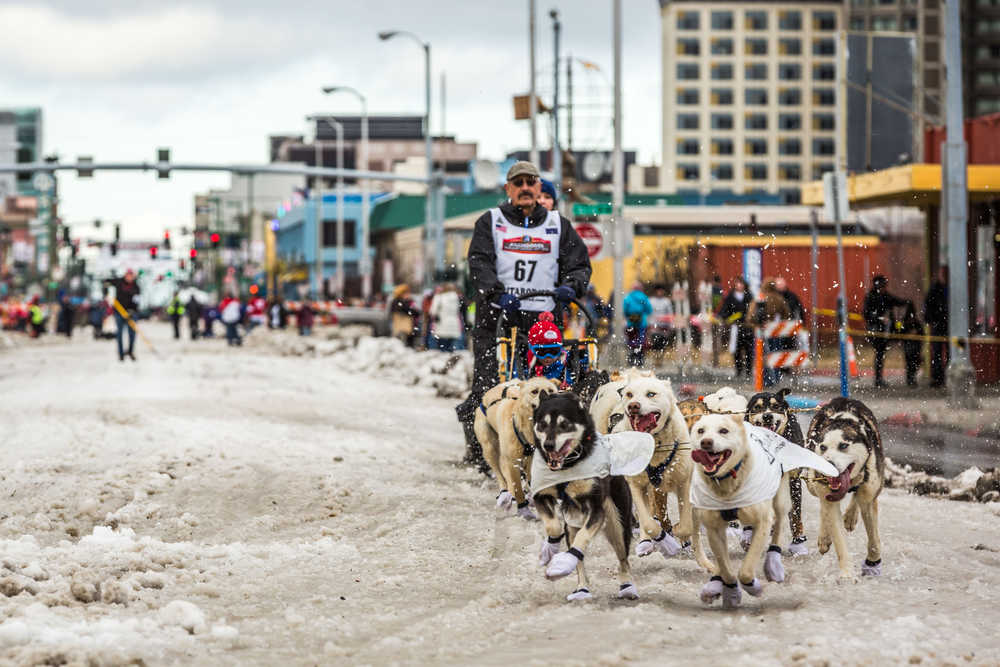ANCHORAGE, Alaska — If there is one day when mushers in the Iditarod sled dog race don’t have to worry about trail conditions, it should be Saturday during the ceremonial start.
A lack of snow south of the Alaska Range created treacherous trail conditions, forcing race officials to move the competitive start of the race to Monday in Fairbanks. A stalled jet stream pushed Arctic air and snow into the Midwest and the East Coast, but kept Alaska fairly warm and dry this winter. But the ceremonial start, a chance for fans and mushers to meet in a casual atmosphere, went on as planned in Alaska’s largest city.
Despite the city receiving only about a third of its normal winter snowfall, Anchorage was still able to stage the traditional ceremonial start to the Iditarod Trail Sled Dog Race. City crews overnight delivered up to 350 dump truck loads of snow and spread it out over city blocks so the show could go on. The festivities started Saturday morning in very un-Iditarod like conditions, almost 40 degrees with a light rain falling before the start.
City maintenance workers stockpiled snow from neighborhoods the past few months and kept it for winter events, culminating with the Iditarod, said Paul VanLandingham with the public works department.
This event is designed for fans who can’t be on the rugged thousand-mile trail stretching from Fairbanks to Nome.
Mushers took off from the start line along Anchorage’s Fourth Avenue every two minutes. Fans lined the streets and cheered on the mushers and their Iditariders, who are people who have won auctions to be in the sled. The route covered 19 city blocks before it met up with the city’s trail system and ends in East Anchorage.
It’s a very relaxed atmosphere before the start. Fans arrive early Saturday morning to mingle with the mushers and pet one of the estimated thousand dogs that will be in the race.
Dan and Kathie Taylor of Akron, Ohio, made their second trip to Alaska after falling in love with the state during an earlier summertime visit. They were surprised how the city prepared.
“I didn’t know that they would bring in snow for this,” Kathie said. “We were wondering what would happen today.”
Kathie said she was struck by the “mushers and just their knowledge, and how they love their dogs unconditionally,” she said. “And how open they are to talk to everybody,” Dan added.
DeeDee Jonrowe, a musher who is a fan favorite, is in her 33rd Iditarod. She spent most of the morning signing autographs, posing for photos and greeting fans like they were long-lost friends.
“It’s an opportunity to show people the dogs I raise, and the quality of the dogs I raise,” she said. “I like that we have a day that we can give back.”
Musher Justin Savidis of Willow said the start is an opportunity to let the dogs shine in the spotlight and let them have some fun.
“You know, if you’re not having fun doing this, there’s no reason to do it,” he said.
Once the event ends, fans and mushers, with their dogs in tow, will drive about eight hours north to Fairbanks. On Monday, the atmosphere changes as mushers will become all about business for the start of the competitive race.
This year’s Iditarod includes 78 mushers, including six former champions and 20 rookies.
The winner will receive a bigger purse, $70,000, which is $19,600 more than what defending champion Dallas Seavey received last year.
The new route will remove the hazards of the Alaska Range, including the infamous Dalzell Gorge, where many mushers crashed last year trying to control dog teams moving at breakneck speeds over barren, gravelly trails. The change will put mushers on river ice for about 600 miles, which could create new problems along the unfamiliar route. The winner is expected under the burled arch in Nome, a Bering Sea coastal town, in about 10 days.
It’s the second time Fairbanks has hosted the official start of the race; similar low-snow conditions in 2003 also forced the start north.

